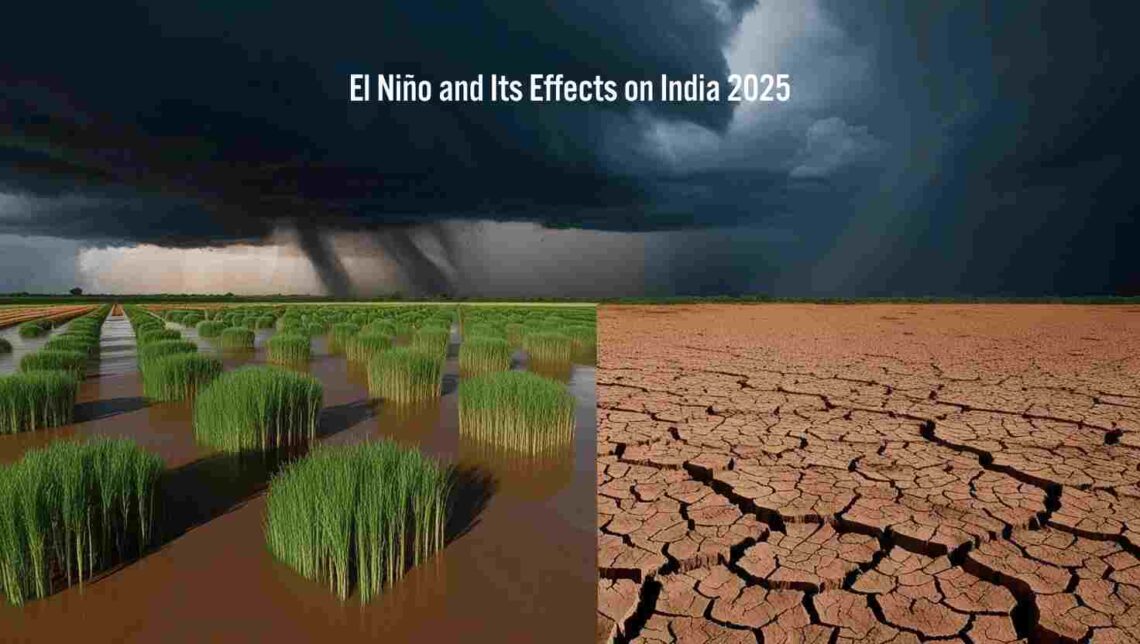
El Niño and Its Effects on India 2025: A Comprehensive Analysis
El Niño and its effects on India can have profound impacts on the country’s climate, agriculture, and economy. This comprehensive guide delves into how this global climate phenomenon disrupts weather patterns, the challenges it presents to India’s monsoon-dependent sectors, and the strategies that can help mitigate its far-reaching consequences.
Understanding El Niño: A Global Climate Disruptor
El Niño refers to the warming of the central and eastern tropical Pacific Ocean, disrupting normal weather patterns. Part of the broader El Niño-Southern Oscillation (ENSO) cycle, El Niño can alter atmospheric circulation, leading to changes in precipitation and temperature globally. For India, El Niño is synonymous with weak monsoons and drought-like conditions, creating challenges for millions dependent on agriculture.
Key Impacts of El Niño on India
1. Weakened Monsoons and Irregular Rainfall
The Indian monsoon is a lifeline for the country’s agriculture, contributing around 80% of the annual rainfall. During El Niño years, the monsoon tends to weaken, leading to deficient rainfall and prolonged dry spells. This irregularity can trigger droughts in critical farming regions like Maharashtra, Gujarat, and Rajasthan, affecting crop productivity and water availability.
2. Agricultural Challenges
Agriculture in India is predominantly rain-fed, making it highly vulnerable to climatic variations. El Niño-induced droughts can result in significant crop failures, particularly for staples like rice, wheat, and pulses. This not only affects farmers’ incomes but also poses a threat to food security, leading to higher food prices and potential shortages.
3. Economic Implications
The impact of El Niño on agriculture has a cascading effect on India’s economy. A weak monsoon can reduce agricultural output, leading to inflation and slowing down economic growth. The rural economy, which depends heavily on agriculture, can face severe stress, affecting demand for goods and services and slowing overall economic activity.
4. Water and Energy Crisis
El Niño often exacerbates water scarcity, affecting both drinking water supply and irrigation. Reduced water availability can also impact hydropower generation, increasing dependency on thermal power plants. This shift can drive up energy costs and contribute to higher greenhouse gas emissions, aggravating environmental concerns.
5. Environmental and Health Concerns
Drought conditions associated with El Niño can lead to environmental degradation, including deforestation, loss of biodiversity, and increased vulnerability to wildfires. Additionally, water shortages and poor sanitation can result in health issues, with outbreaks of diseases such as cholera and diarrhea becoming more common during drought periods.
Mitigation Strategies for El Niño’s Impact
1. Advanced Climate Forecasting
Enhancing the accuracy of weather forecasts can help predict El Niño events well in advance. Early warning systems enable governments and farmers to prepare for potential droughts, reducing the impact on agriculture and water resources. Investments in meteorological infrastructure and research are crucial for better preparedness.
2. Promoting Drought-Resistant Crops
Encouraging the cultivation of drought-resistant and short-duration crops can help mitigate the risks associated with El Niño. Crop diversification reduces dependency on water-intensive crops and enhances agricultural resilience. Government policies promoting such practices through subsidies and education can significantly impact.
3. Efficient Water Management
Adopting water conservation techniques like rainwater harvesting, drip irrigation, and constructing check dams can help optimize water usage. These measures can ensure water availability during dry spells, supporting agriculture and reducing the strain on water resources.
4. Strengthening Agricultural Policies
Implementing robust agricultural policies, including crop insurance and financial support for farmers, can cushion the impact of El Niño. Creating grain reserves and stabilizing food prices can help prevent economic distress and ensure food security during low rainfall years.
5. Public Awareness and Community Engagement
Raising awareness about El Niño and its effects can empower communities to take proactive measures. Educational campaigns and community involvement in water conservation and sustainable farming practices can build resilience against climate variability.
Conclusion: Navigating El Niño’s Challenges
El Niño’s impact on India is multifaceted, affecting weather patterns, agriculture, and the broader economy. As climate change continues to influence global weather systems, understanding and preparing for El Niño is more crucial than ever. By investing in research, adopting sustainable practices, and enhancing policy frameworks, India can mitigate the adverse effects of this climatic phenomenon.
Stay ahead of the curve with the latest updates on climate trends and their impact on India at SimplyKnowHow.com. We bring you insights that are not only informative but also actionable, helping you navigate the complexities of our changing world.



